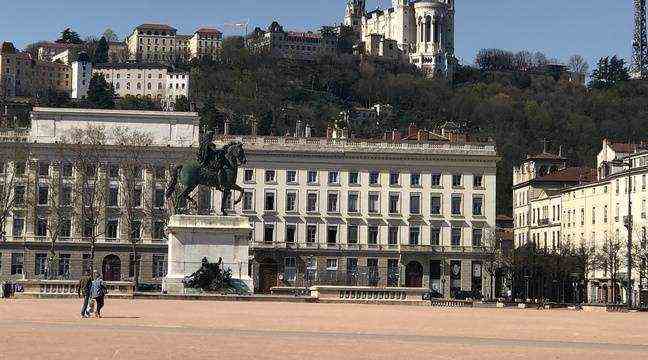Illustration of the first confinement in the streets of Lyon. Here place Bellecour – C. Girardon / 20 Minutes
- From midnight this Friday, the Rhône will be one of the new reconfigured departments.
- A decision due to a rapid “worsening” of the health situation which could have a significant impact on hospital activity, according to the authorities who gave a detailed update on the epidemic on Friday.
Like an air of déjà vu. At midnight this Friday, the Rhône will be one of the 19 French departments reconfigured, where the Covid-19 virus is circulating the most strongly. A decision taken by the government on Thursday after a marked deterioration in the epidemic monitoring indicators. “The Rhone is well into the third wave”, estimated this Friday afternoon the prefect of the Rhône Pascal Mailhos, during an update on the situation organized with the ARS. 20 minutes details the data that led the authorities to take another turn in the region, where – a small positive touch – the health situation “only partially” resembles the second wave that hit the Rhône with virulence, according to the ARS in autumn.
A strong “viral acceleration”
“The Rhône is now facing a high level of contamination”, recalled the prefect of the department, with an incidence rate which has soared in a month, and even more strongly in the last ten days. Between February 25 and March 25, this rate, which measures the circulation of the virus within the population, increased by 80%. It amounts to 415 cases per 100,000 inhabitants in the Rhône (417 in the metropolitan area of Lyon), i.e. well above the alert threshold set at 250 per 100,000 inhabitants. This strong increase is significantly higher than at the national level, where it is estimated at 51%. One factor may explain the rapid deterioration of the situation: the English variant.
The latter, more contagious, now represents “83% of positive Covid tests recorded in the Rhône (77% nationally), according to Serge Morais, deputy director general of ARS Auvergne Rhône-Alpes. At the beginning of March, it only represented 50% of contaminations ”.
New “anticipated” hospital tensions
Since the start of this global pandemic, the marked change in the incidence rate has systematically resulted in an increase in hospitalizations. A feared scenario in the Rhône, where after a year of epidemic and pressure that has remained at a high level, staff are at the end of their rope. Over the past ten days, hospitalizations related to Covid have increased from 922 to 953 on March 25 and, in intensive care, teams have had to deal with a “real” increase in admissions. Today, 193 coronavirus patients are treated in critical care against 163 in mid-March. Unlike the first two waves, “younger patients with no proven co-morbidities” are admitted in shifts, which, according to the ARS, seems to be in line with a recent study carried out in England concluding that there is greater contagiousness and dangerousness. of the British variant. “There is a real impact on the resuscitation services. We must therefore anticipate and ensure that we are always one step ahead, ”adds Serge Morais.
One of the main levers for unloading these services remains the opening of beds. From next week, thirty additional beds should be equipped in the Rhône and the Loire, bringing the capacity in sheaves to more than 800 in Auvergne Rhône-Alpes. The ARS has also asked health establishments in the greater region to provide a detailed update on their reception capacities in intensive care, said the deputy director, who does not rule out possible deprogramming of non-urgent activities in the Rhône. According to our information, a message to this effect has already been sent to health establishments for the beginning of next week.
Vaccination is expected to accelerate significantly
This is a parameter which makes it possible to envisage a third wave that is less virulent than the second. “The effects of the vaccine are starting to be felt,” says Serge Morais, especially among those over 75, for whom the incidence rate has stabilized. In nursing homes, where 92% of residents received a first dose, the number of clusters has also fallen. To limit the impact of the virus, the “vaccine is a weapon that must be deployed on the territory”, he adds. A weapon, however, lightly loaded for the time being in the Rhône where, since January 18, only 9.3% of the inhabitants have received a first dose. This rate climbs to 54% for those aged 75 and over and 44% of health professionals have been vaccinated. In April, five additional centers are due to open, bringing the number of facilities able to immunize to 30. “The objective is for the existing centers to increase their vaccination capacity,” adds Serge Morais.
For this, the authorities are counting on an increase in the doses of Pfizer, Moderna and AstraZeneca delivered each week in the department. For the Pfizer / BioNTech messenger RNA vaccine alone, 30,400 doses are expected next week and 40,950 the following weeks against 22,500 at present. If all goes according to plan, the vaccination centers should be in full swing. At the Gerland Sports Palace in Lyon, where 100 staff are mobilized to vaccinate the public, this reinforcement of doses should give rise to 14,000 vaccinations per week, according to the ARS. That is almost six times more than today.

